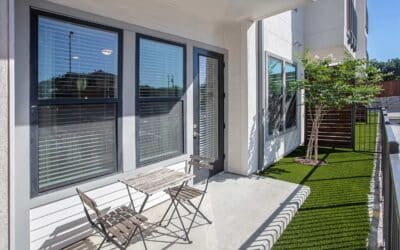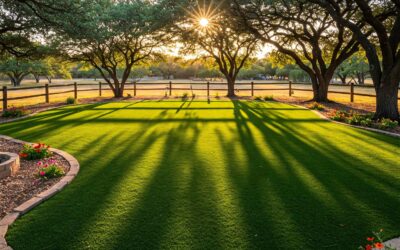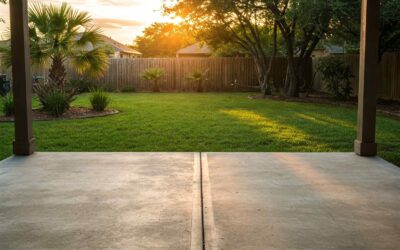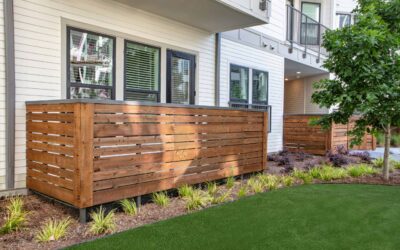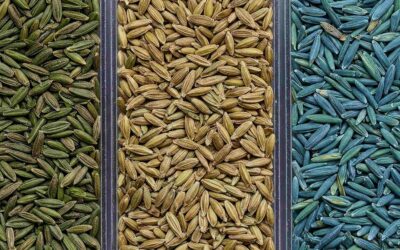Read time: 6-7 minutes
There’s no getting away from the big question in dog owners’ minds when they’re considering backyard artificial grass as an option.
“Can my dog pee on the artificial grass you install?”
They’ve experienced the tell-tale yellow rings from dog pee on natural grass and want to know what they’re letting themselves in for with fake grass.
Well, there’s good news and bad news when it comes to pet turf for dog owners — though the bad news is not particularly bad.
Yes, your dog can pee safely on artificial grass if it’s installed correctly. The bad news is that artificial grass is not 100 percent maintenance-free (as it’s sometimes made out to be) if you have dogs.
Let’s dive into what dog owners need to know about synthetic grass and consider how you and your family can maintain a pristine, odor-free backyard (or front yard) area despite the worst efforts of your pooch…
Why artificial grass works for dogs
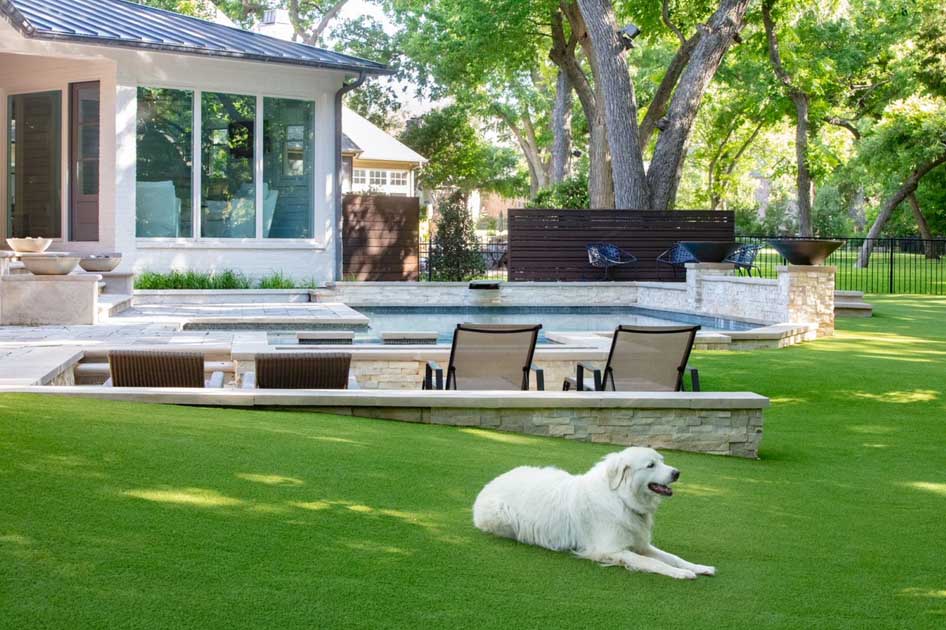
A happy dog goes a long way to a happy family. That’s why approximately 48 million American households own a dog.
If you have a sizable backyard, your dog likely loves a daily run out there — and that doesn’t need to change if you install artificial grass there.
While natural grass yellows when splashed with dog urine and is difficult to return to its verdant green best, artificial grass doesn’t discolor from dog pee or other contaminants.
The artificial grass surface has a porous backing that allows pet urine to seep through and drain away. While odors from dog pee are unusual, a little maintenance can also help to prevent any buildup of nasty smells (see below).
There are other good reasons to install pet turf. Most notably:
- No more mud: even during a Texan storm, artificial grass doesn’t turn muddy so you won’t have a mud-splattered dog wandering around on the new carpet and you won’t have to bathe your dog after rains.
- No holes in the yard: digging up the lawn seems to be a “pet love” of dogs as they search for that mystery bone or long-lost toy (who knows?) but you don’t have to worry about that with artificial grass.
- Fewer bugs, ticks and fleas: natural grass tends to trap organic debris and bacteria in its soil, which attracts bugs, ticks and fleas that can spread to your dog’s fur; with synthetic grass, no soil or bacteria traps means this is far less likely, especially if you take these steps to remove bugs.
- Safety: your dog can run around without being exposed to toxins, fertilizers or weedkillers (just beware of cheap grass that may contain harmful chemicals).
These reasons have encouraged many dog parks and daycare centers to choose artificial pet turf installation over traditional lawns too:
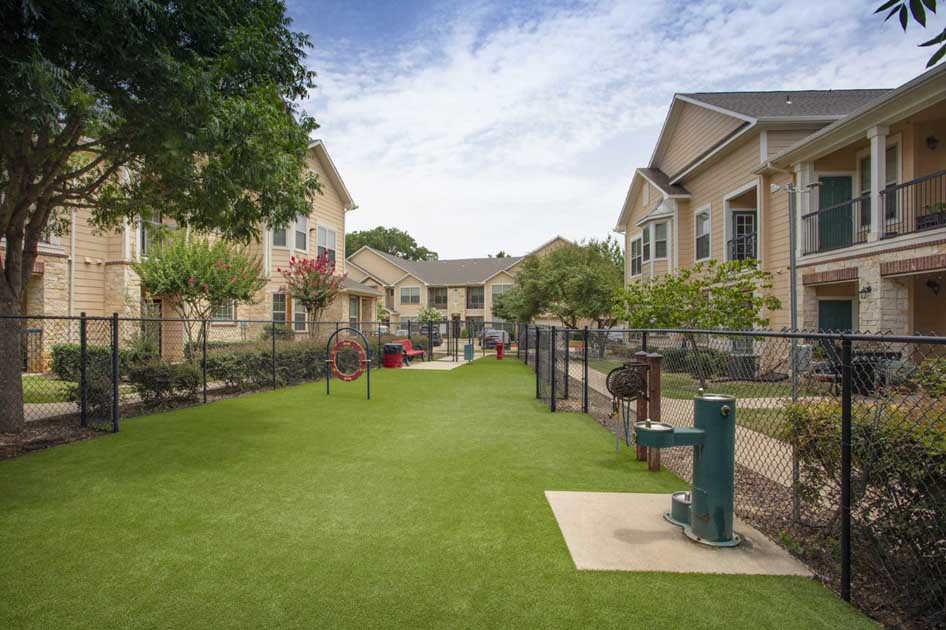
Is artificial grass durable enough for dogs?
Another major concern of dog owners is whether the pet turf they install will stand up to the extra wear and tear that excited dog paws can put it through.
A high-quality pet turf installed by professionals should be tough and durable enough to last 10-15 years even with dogs charging around and the Texan sun to deal with.
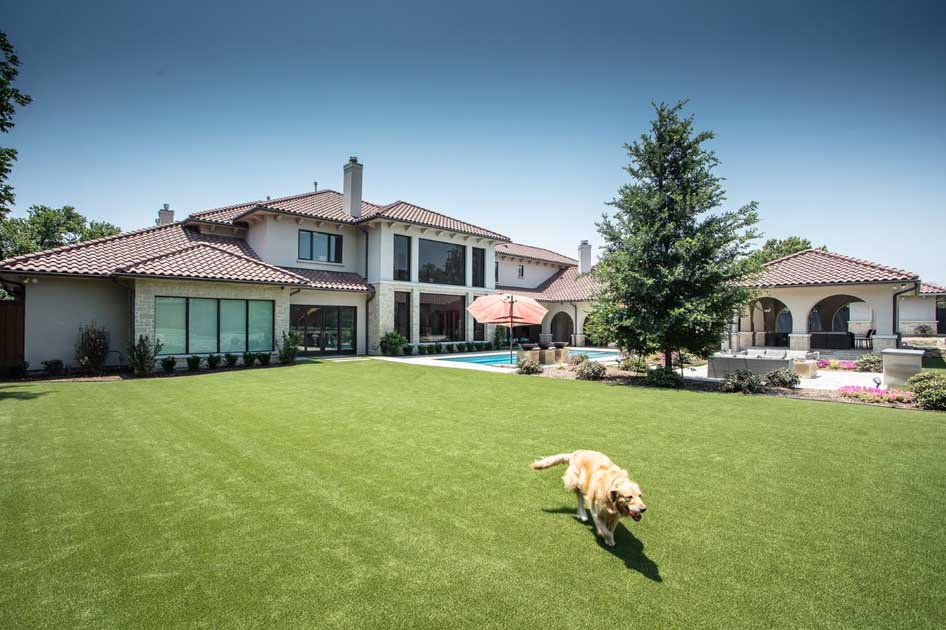
Can dogs poop on artificial grass?
While on the highly engaging subject of the toilet habits of your dog(!), many homeowners also want to know whether their dog can poop on the artificial lawn they’ve just laid in the backyard.
The answer again is yes — as long as you clean up afterwards as you would do with a natural grass lawn. This brings us to the topic of maintaining your artificial grass space when you have dogs…
How should you maintain artificial grass when you have dogs?
Artificial lawns require some basic maintenance but far less than a real grass lawn. There’s no mowing, fertilizing, weeding or great need to water but it’s a good idea to brush off any debris that gathers on your lawn and to occasionally hose it down.
When you have dogs peeing and pooping on your lawn, there’s a little more work to do as you can probably imagine. Just to keep things nice and sanitary, you should perform regular checks for any “nasties”, especially if your children use the same space as a kids’ play area or you enjoy picnics on your lawn with your family.
Dog poop generally needs swift scooping up if possible – as you would do with natural grass. Then hose the area down (using a hose with decent pressure) to remove any remaining residue. If your lawn has been installed professionally with good drainage, it should be relatively easy to keep your lawn completely poop-free.

These measures will also help to remove any potential odors from lingering dog pee. As we know, dogs love to pee in the same spots again and again, so if you are having trouble removing odors, mix bicarbonate of soda onto the area and spray it with vinegar to eradicate nasty smells without it harming your dog or your family.
There are also some commercial products available for turf cleaning when you have dogs but be careful to select only non-toxic products with safe, organic ingredients. The best products are enzyme or biocidal-based cleaners.
How do you install artificial grass for dogs?
Artificial grass for dogs is installed in a similar way to all artificial grass spaces — but with an additional measure or two.
Real grass has a natural drainage system for rain and dog urine. With artificial grass, how well your area drains will largely be down to the skills and experience of your installation team.
To avoid fluids accumulating on the surface, the fake grass should be of sufficient quality but that’s not all.
The sub-base should be sand-free but able to cope with the extra load. Sand or silica holds onto the uric acid crystals in dog wee, increasing the likelihood of nasty smells. At the same time, it must provide adequate drainage to allow fluids to rapidly drain away.
Additionally, it’s best to use a latex-free synthetic turf with a polyurethane backing that doesn’t absorb urine over time.
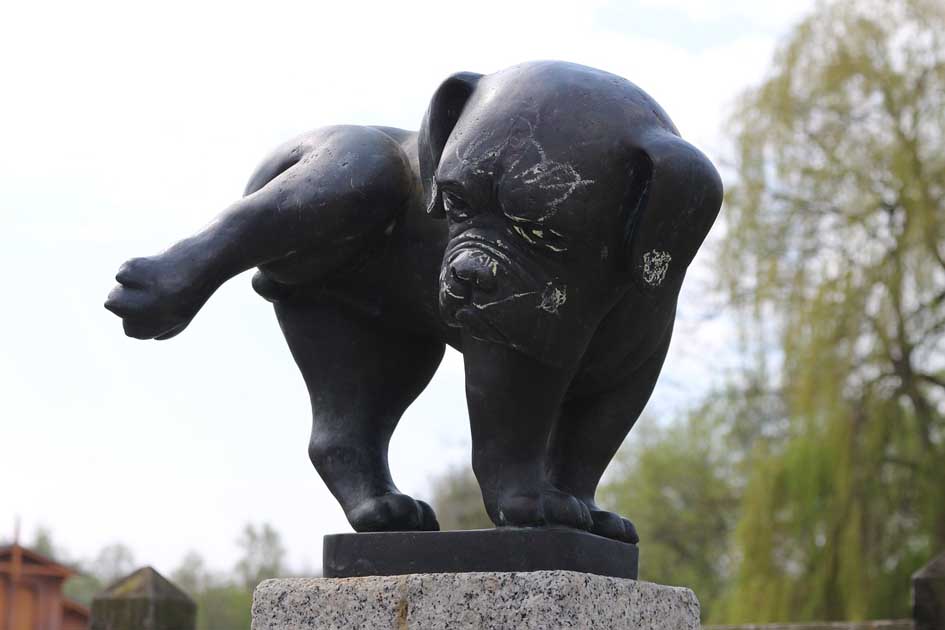
Finally, the infill that helps your artificial grass look and feel more like natural grass is usually made from crumb rubber, sand and/or silica granules. Selecting a sand-free and antimicrobial infill is best if you have dogs. This will ensure that the infill doesn’t trap ammonia, nitrates and bacteria that are responsible for the nasty odors from dog waste.
Professional installers like the team at Artificial Grass Pros use pet turf with a drainage rate of 30+ inches of rain per hour per square yard. Along with the use of antimicrobial infill and a suitable sub-base, this ensures that dog pee doesn’t cause any assault on the nostrils.
Are there any downsides to pet turf?
We’re not going to lie to you. Artificial grass may be a godsend for many homes in Texas but it might not be for everyone.
Most of the objections people have can be overcome by making sure you install high-quality grass that is fit for the purpose you intend it — and getting it installed by seasoned professionals.
However, a few common downsides for dog owners are the following:
- Higher upfront costs: installing synthetic grass ($8-12 per square foot) is more expensive than real grass ($1-2 per square foot); the payback comes during the years of low water usage and lower maintenance costs that follow.
- Some low-quality artificial grass has toxic components: cheap imported artificial grass may not be suitable for dogs (or your family) because it’s made with substandard toxic chemicals that include lead, cadmium, and phthalates. The pet turf installed by Artificial Grass Pros is all high-quality, toxin-free grass that is ideal for dogs and the Texan climate.
- Low-quality grass may overheat in strong sunlight: again, it’s best to keep away from cheaper imported grasses that heat up excessively in strong sunlight and may make it uncomfortable for dog paws. Our team uses pet turf that doesn’t overheat and you can take these steps to keep your pet turf cool in summer.
- Low-quality grass may not withstand the rough and tumble of your dog’s paws or claws and could require regular repairs.

FAQs
How much is artificial grass for dogs?
The cost of synthetic grass for dogs depends on multiple factors, including the quality of turf, the size of the area, the size of your dog, the ease of access/installation complications, and so on.
We’ve written a whole post on the cost of artificial grass that you can check out for more detail.
Is artificial grass safe for dogs?
Yes, synthetic dog turf is safe for dogs if you select good quality, non-toxic grass from a professional supplier/installer.
Your dog is more likely to develop problems with the types of pesticides, herbicides, mulch and fertilizers used on or near natural grass than with most artificial grass.
How can I tell if my grass contains toxins that are harmful to my dog?
Cheaper, imported pet turf may not be labeled with all of its components. If your artificial grass seems too cheap to be true, it’s probably worth avoiding.
Get a few quotes so you know what a good ballpark figure is and then opt for the most reliable supplier/installer with the best reviews.
Get your pet turf installed by the pros…
Artificial grass is robust enough to withstand most of what your dog can throw at it.
But installing an artificial grass area should not be taken lightly. It is not a DIY job unless you have considerable experience and, when you have dogs, it’s even more important to get it right.
At Artificial Grass Pros, we can look after your artificial turf project from start to finish. Discuss your ideas by reaching out to our helpful team. We’ll be happy to provide a quote. Call 512.296.1500.

